Q. What are the functions of respiratory system?
A. Functions of Respiratory system
Respiratory system comprises of structures involved in:
- inhalation of air,
- exchange of oxygen and carbon dioxide between inhaled air and blood and
- exhalation of carbon dioxide
Besides respiration, it is also responsible for olfaction and phonation (sound production) .
Q. What are the parts of respiratory system?
A. Parts of Respiratory system : Consists of Two parts
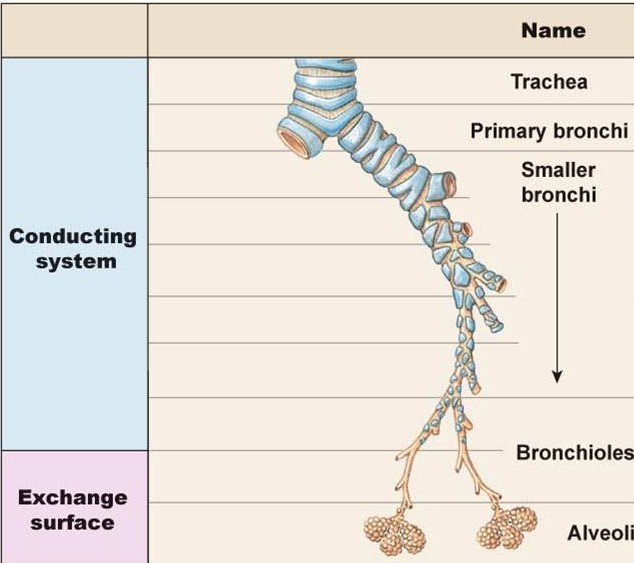
Parts of Respiratory System
a. Conducting part:
Transports, Warms, Humidifies & Filters air. Includes nasal cavity, pharynx, larynx, trachea, bronchi, bronchioles till terminal bronchioles.
b. Respiratory part:
Allows gaseous Exchange. Includes respiratory bronchioles, alveolar ducts, alveolar sacs and alveoli.
Q. What are the layers of wall of conducting part of respiratory system?
A. In general, the wall of conducting part consists of Four layers (from lumen to outside)
General structure of Wall of Conducting Part

- Mucosa
- a. Epithelium : Pseudostratified ciliated columnar with goblet cells.
- b. Lamina propria: beneath epithelium, consists of loose connective tissue.
- Submucosa
- Loose connective tissue with mixed glands
- (mucous and serous glands).
- Cartilage
- Hyaline cartilage. Prevents airways from collapsing.
- Adventitia
- Fibroelastic connective tissue blends with surrounding tissue.
Q. Enumerate the cells of respiratory epithelium and their function.
A. Cells of respiratory epithelium and their function are:
1. Columnar ciliated cells: Ciliary movement sweeps mucus and the dust toward the pharynx and nasal cavity.
2. Goblet cells: Secrete mucus, which moistens the epithelial surface and trap inhaled particles (dust and bacteria).
3. Basal cells: Source of ciliated columnar and goblet cells.
and goblet cells.
4. Brush cells (with microvilli): Sensory cells
5. Granule cells: Paracrine cells – Secrete , Norepinephrine, epinephrine and 5-Hydroxytryptamine.
Q. What structural changes occur in the wall of respiratory tract from trachea to terminal bronchiole?
A. Structural changes in the wall of respiratory tract from trachea to terminal bronchiole:
Epithelium –Thickness decreases (Pseudostratified to simple columnar)
Goblet cells–Decrease in number and absent in bronchioles.
Submucosal gland–Decrease in number and absent in bronchioles.
Cartilage–C-shape in trachea to plates in bronchii and absent in bronchioles.
Elastic fiberes–Increase in amount
Smooth muscle –Relative increase.
Q. What is the lining epithelium of different regions of nasal cavity?
A. Structurally nasal cavity has three regions:
- Vesibule: Is lined by stratified squamous epithelium having sebaceous glands and short thick hair called vibrissae.
- Respiratory region: Is lined by pesudostratified ciliated columar epithelium.
- Olfactory region: is in the upper part of nasal cavity and is lined by plfactory epithelium ( specialized pseudostratified epithelium)
Q. Describe histological structure of olfactory mucosa.
A. Structure of olfactory mucosa:
a. Epithelium has three types of cells:
- Olfactory cells: Bipolar neurons – responsible for sense of smell.
- Supporting/sustentacular cells: Tall cells with Micovilli.
- Basal cells: small cells which do not reach the surface.
b. Lamina propria: Contains Bowman’s glands which secrete thin watery mucus.
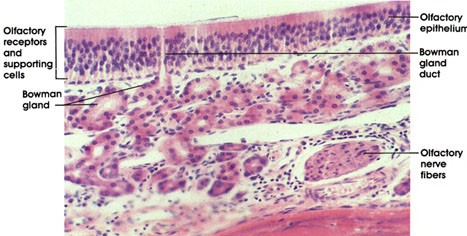
Q. What is the epithelial lining of laryngeal cavity?
A. The lining epithelium varies in different parts of larynx.
i. Laryngeal inlet, most of epiglottis and true vocal cords are covered by stratified squamous non- keratinized epithelium.
ii. Rest of larynx is lined by respiratory epithelium i.e. pseudostratified columnar ciliated epithelium with goblet cells.
Q. Describe the microscopic structure of false and true vocal folds.
A. There are two pairs of folds of mucosa projecting inside the laryngeal cavity.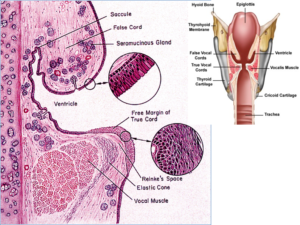
a. False vocal folds or vestibular folds: Theses are the upper pair of foldsand are formed of a central core of lamina propria containing mixed (predominantly mucous) glands and covered with pseudostratified columnar ciliated epithelium with goblet cells
b. True vocal cords: These are the lower pair of folds and are formed of a central core of lamina propria, which is rich in skeletal muscle fibres (vocalis), bundles of elastic fibres (vocal ligament)and glands. The folds are covered with non- keratinized stratified squamous epithelium.
Q. Describe the microscopic structure of epiglottis.
A. Epiglottis is a leaf like structure & consists of a plate of elastic cartilage covered on both sides by mucosa. It has two surfaces:
- Lingual/anterior surface
- Laryngeal/posterior surface
Epithelium
Lingual/pharyngeal surface and upper part of laryngeal surface are covered by non-keratinized stratified squamous epithelium.
Lower part of laryngeal surface is covered by pseudostratified columnar ciliated epithelium
Lamina propria
Consists of connective tissue with serous and mucous glands.
Cartilage
Elastic cartilage deep to lamina propria forms the framework of epiglottis.
Q. What are the layers in the wall of trachea? Describe the microscopic features of each layer.
a. Mucosa: Epithelium and lamina propria. 
i. Epithelium: Ciliated pseudostratified columnar epithelium with, goblet cells, basal cells, and neuroendocrine cells.
ii. Lamina propria: Conatins connective tissue, mixed glands, lymphocytes (BALT).
b. Submucosa: dense connective tissue and seromucous glands
c. Cartilage & smooth muscle layer : C-shaped hyaline cartilage & trachealis muscle.
d. Adventitia: Fibroelastic connective tissue.
Q. Name the airways present in the lung.
A. The lungs’ airways intrapulmonary bronchi divide into smaller and smaller branches and end in air sacs (alveoli). The airways in the lung are :
i. Intrapulmonary bronchi ( lobar/secondary and segmental/tertiary bronchi)
ii. Bronchioles (terminal and respiratory bronchioles).
iii. Alveolar ducts, alveolar sacs & alveoli.
Q. Describe the microscopic structure of intrapulmonary bronchus.
A. Intrapulmonary bronchus wall has the same layers as in trachea with few differences which are as follows:

Epithelium: Pseudostratified ciliated columnar epithelium is shorter and has fewer goblet cells.
Lamina propria is rich in elastic fibres.
Smooth muscle ( spirally arranged) : between mucosa and submucosa. Mucosa is thrown into folds due to contraction of smooth muscle.
Submucosa: fewer seromucous glands
Hyaline cartilage: is in the form of plates which encircle the bronchus.
Adventitia: is thinner.
Q. What are the characteristic microscopic features of terminal bronchiole?
A. Characteristic microscopic features of terminal bronchiole include:
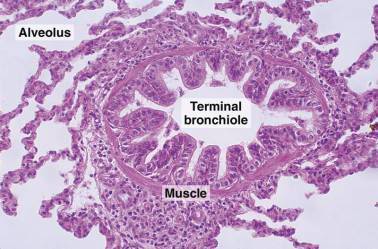
Epithelium: Is simple columnar or cuboidal ciliated has no goblet cells. Has Clara cells (dome shaped cells without cilia secrete glycosaminoglycans and secretory proteins) .
Smooth muscle layer is thick and prominent.
Mucosa is thrown into folds due to contraction of smooth muscles.
No glands in submucosa
No cartilage
Have diameter less than 1mm.
Q. What are the characteristic microscopic features of repiratory bronchiole?
A. Characteristic microscopic features of repiratory bronchiole include:
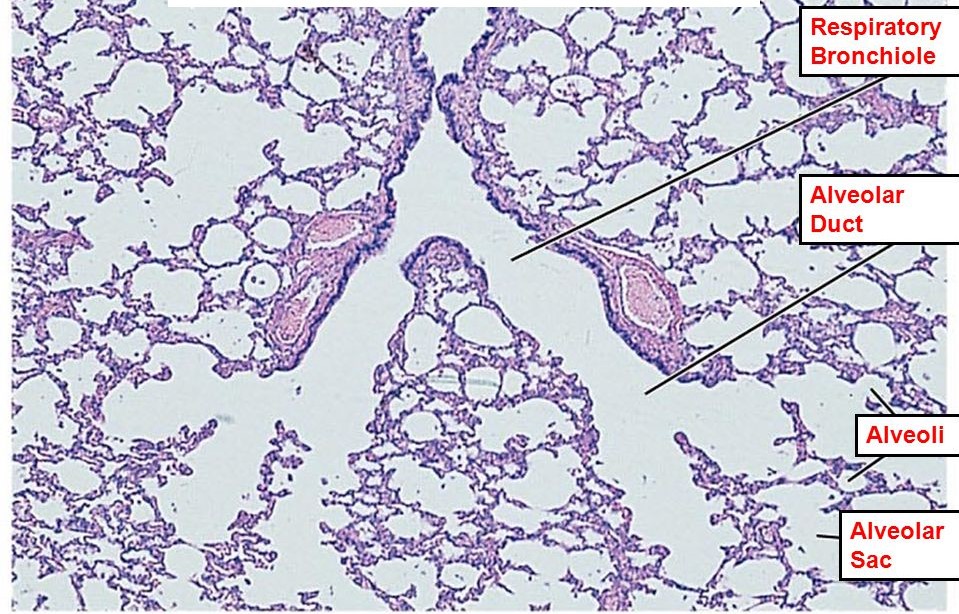
Epithelium : simple non-ciliated cuboidal and no goblet cells.
Epithelium is interrupted by presence of alveoli (gas exchange begins to occur in the respiratory alveoli that bud from the respiratory bronchioles).
Thin layer of smooth muscle.
Q. Describe the microscopic features of terminal part of respiratory tree i.e. alveolar duct, alveolar sac and alveoli.
A. Each respiratory bronchiole divides into long passages called alveolar ducts which lead into alveolar sacs, each of which has opening of several alveoli into it. Alveolar duct and sacs are lined by simple squamous epithelium.
Alveoli: Are thin walled outpocktings which allow for the rapid diffusion of gases between the air space and the blood. They are lined by flattened epithelium consisting of two types of cells:
Pneumocyte type I 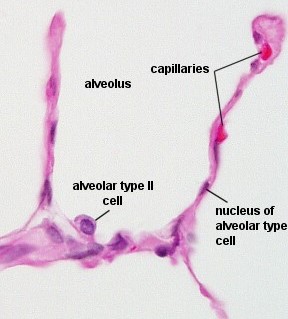
Line most of the alvolar luminal surface ( 95-97%).
Are simple squamous cells.
Allow gaseous exchange.
Pneumocyte type II
Fewer than pneumocyte I ( line 5% of surface).
Are simple cuboidal cells.
Secrete surfactant which lowers the surface tension and prevents alveoli from collapsing.
Q. What are the components of interalveolar septum and the stuctures forming Blood-Air barrier?
An interalveolar septum consists of
- Two thin squamous epithelial cell layers of adjacent alveoli and between the epithelial layers lie capillaries, elastic and collagen fibers, macrophages and fibroblasts. The septa are perforated by alveolar pores Kohn which allow equalization of pressure between the adjacent alveoli.
The components of Blood – Air barrier are:
1. Squamous cells of alveoli .
2. Basement membrane of alveoli.
3. Basement membrane of capillaries.
4. Endothelium of capillaries is about .5 μ in thick.
